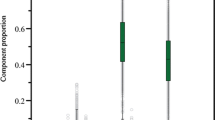Abstract
A 21-plex DIP (deletion and insertion polymorphism) panel has a good performance in analyzing biogeographic ancestry in three main global population groups (European, African, and Asian). This panel was used to investigate 450 unrelated individuals in seven Chinese ethnic groups (Han, Dong, Miao, Zhuang, Uyghur, Tibetan, and Mongolian). Allele frequencies were calculated. Mho (mean value of observed heterozygosity) ranged from 0.3019 to 0.4367, MHe (mean value of expected heterozygosity) ranged from 0.31175 to 0.38341, CMP (combined matching probability) ranged from 3.5834E-07 to 2.5985E-06, CDP (combined power of discrimination) ranged from 0.99999740150 to 0.99999964166, and CPE (combined power of paternity exclusion) ranged from 0.85884504 to 0.97949131. The results suggested the potential of the panel for individual identification and paternity testing in Chinese populations. Pairwise genetic differences Fst values (−0.00091 to 0.05873) and the analysis by STRUCTURE indicated that Chinese populations have good internal consistency.
Similar content being viewed by others
Change history
26 February 2020
‘Concerns have been raised about the ethics approval and informed consent procedures related to the research reported in this paper. The paper includes the following author declarations:
“Four hundred and fifty samples were collected with informed consent from the donors”
“All procedures performed in this study involving human participants were in accordance with the ethical standards of the Ethics Committee of Sichuan University, China.”
Editorial action will be taken as appropriate once an investigation of the concerns is complete and all parties have been given an opportunity to respond in full.’
References
Phillips C (2015) Forensic genetic analysis of bio-geographical ancestry. Forensic Sci Int Genet 18:49–65. doi:10.1016/j.fsigen.2015.05.012
Zaumsegel D, Rothschild MA, Schneider PM (2013) A 21 marker insertion deletion polymorphism panel to study biogeographic ancestry. Forensic Sci Int Genet 7(2):305–312. doi:10.1016/j.fsigen.2012.12.007
National Bureau of Statistics of the People’s Republic of China (2010) Tabulation on the 2010 population census of The People’s Republic of China. National Bureau of Statistics of China. http://www.stats.gov.cn/tjsj/pcsj/rkpc/6rp/indexch. Accessed 27 March 2017
China.org.cn.(2016) Ethnic Groups. China.org.cn. http://www.china.org.cn/e-groups/shaoshu/shao-2-zhuang. Accessed 27 March 2017
Walsh PS, Metzger D, Higuchi R (1991) Chelex 100 as a medium for simple extraction of DNA for PCR-based typing from forensic material. BioTechniques 10:506–513
Excoffier L, Lischer HE (2010) Arlequin suite ver 3.5: a new series of programs to perform population genetics analyses under Linux and Windows. Mol Ecol Resour 10(3):564–567. doi:10.1111/j.1755-0998.2010.02847.x
Pritchard JK, Stephens M, Donnelly P (2000) Inference of population structure using multilocus genotype data. Mol Ecol Resour 155(2):945–959
Falush D, Stephens M, Pritchard JK (2003) Inference of population structure using multilocus genotype data: linked loci and correlated allele frequencies. Genetics 164(4):1567–1587
Falush D, Stephens M, Pritchard JK (2007) Inference of population structure using multilocus genotype data: dominant markers and null alleles. Mol Ecol Notes 7(4):574–578. doi:10.1111/j.1471-8286.2007.01758.x
Jakobsson M, Rosenberg NA (2007) CLUMPP: a cluster matching and permutation program for dealing with label switching and multimodality in analysis of population structure. Bioinformatics 23(14):1801–1806. doi:10.1093/bioinformatics/btm233
Rosenberg NA (2003) Distruct: a program for the graphical display of population structure. Mol Ecol Notes 4(1):137–138. doi:10.1046/j.1471-8286.2003.00566.x
Earl DA, vonHoldt BM (2011) STRUCTURE HARVESTER: a website and program for visualizing STRUCTURE output and implementing the Evanno method. Conserv Genet Resour 4(2):359–361. doi:10.1007/s12686-011-9548-7
Acknowledgements
This work was supported by Grants from the National Natural Science Foundation of China (No. 81671871), and the authors would like to thank all contributors who participate to the study.
Author information
Authors and Affiliations
Corresponding authors
Ethics declarations
All procedures performed in this study involving human participants were in accordance with the ethical standards of the Ethics Committee of Sichuan University, China.
Conflict of interest
The authors declare that they have no conflict of interest.
Rights and permissions
About this article
Cite this article
Jiang, Y., He, W., Wang, H. et al. Population genetic analysis of a 21-plex DIP panel in seven Chinese ethnic populations. Int J Legal Med 132, 145–147 (2018). https://doi.org/10.1007/s00414-017-1639-x
Received:
Accepted:
Published:
Issue Date:
DOI: https://doi.org/10.1007/s00414-017-1639-x




